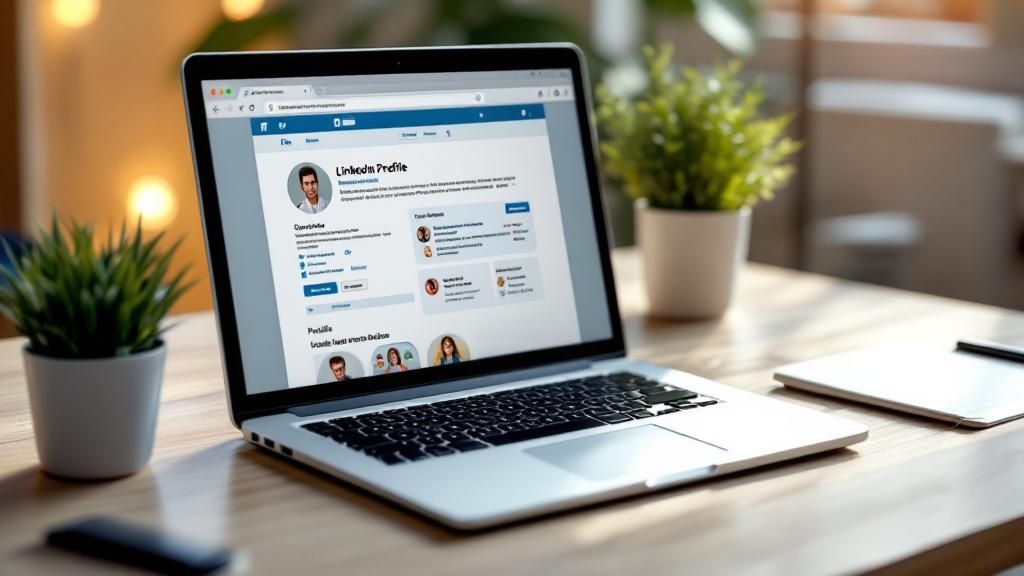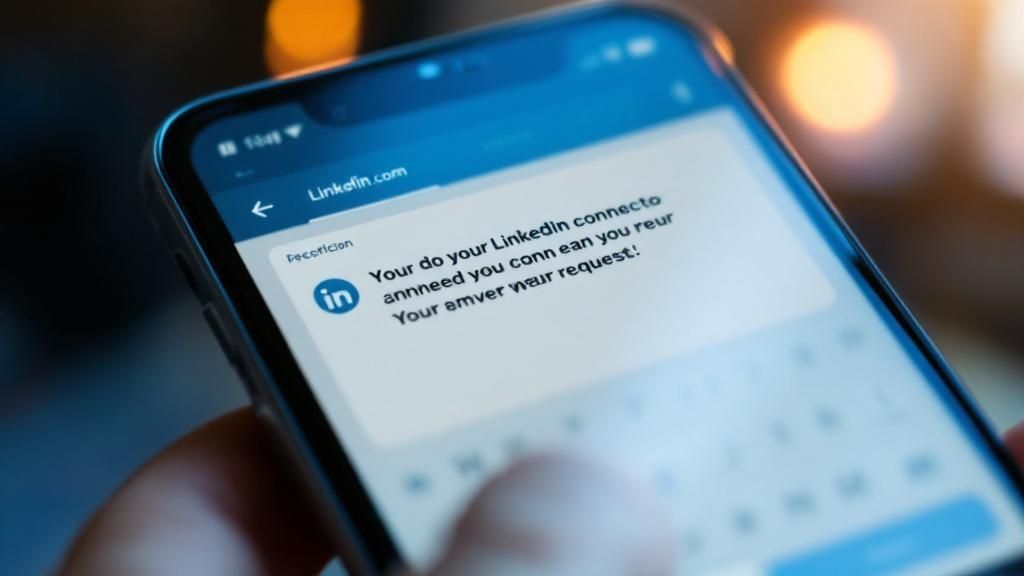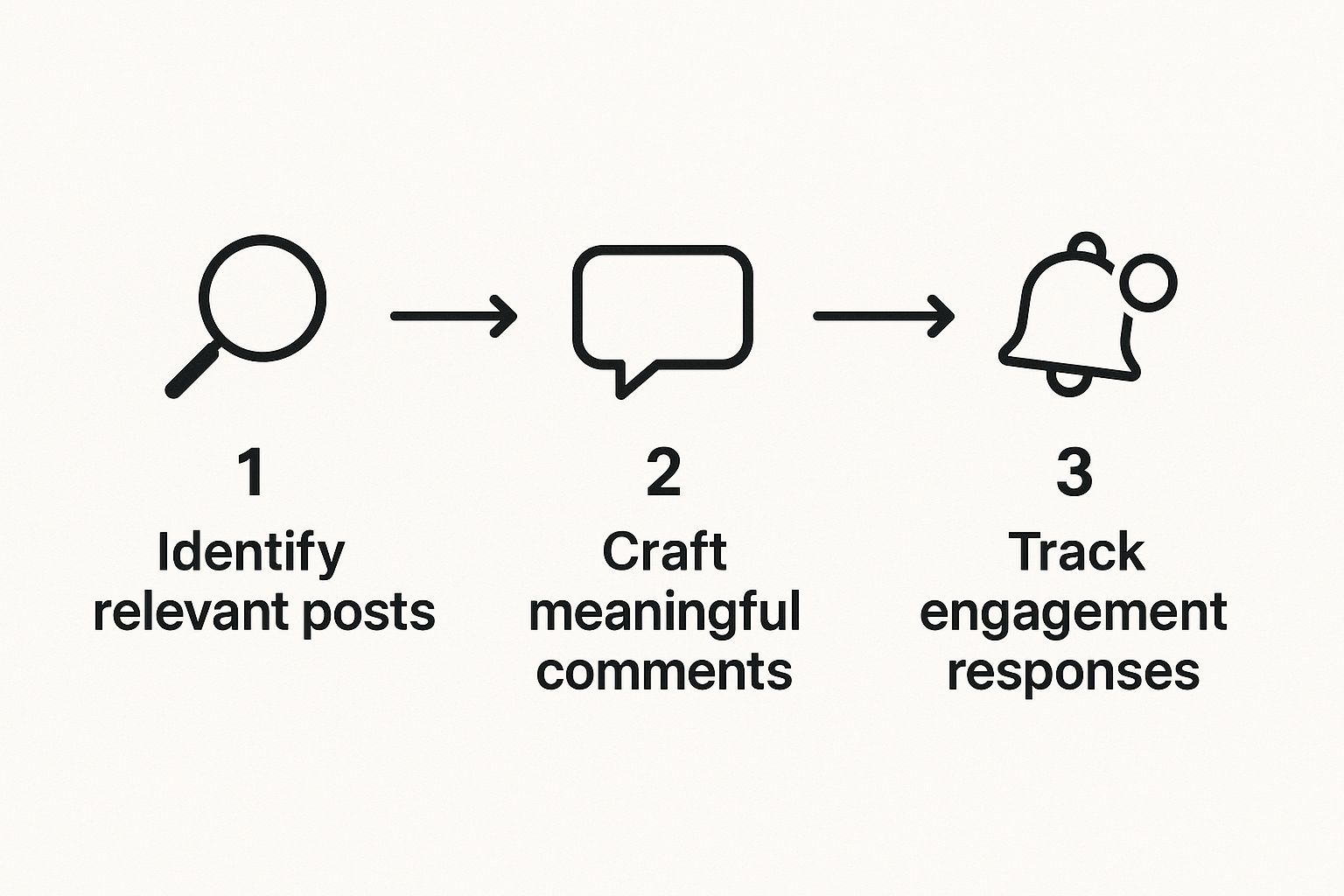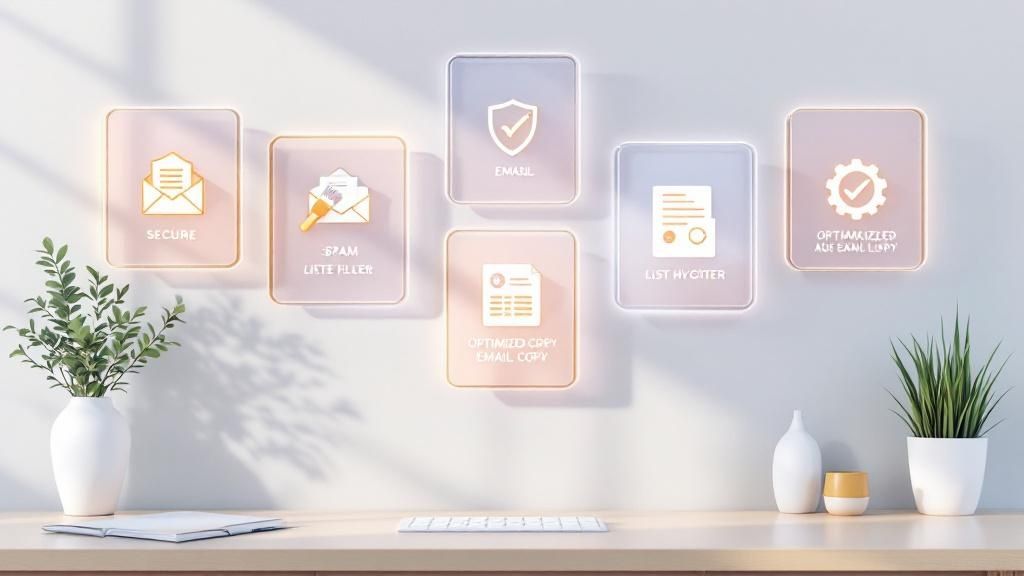Getting traction on LinkedIn really just comes down to three things: sprucing up your profile, making every connection request personal, and following up with something valuable. When you get this right, your profile stops being a static resume and starts working for you, building real professional relationships.
Build a Profile That Actually Invites Connections

Before you even think about sending a single connection request, you have to get your own house in order. Your LinkedIn profile needs to make a killer first impression. This isn't just about filling in the blanks; it's about building a narrative that resonates with the exact people you want to connect with.
Think of your profile as your digital handshake. It needs to be firm, confident, and welcoming.
When someone gets your request, what's the first thing they do? They click on your profile. That quick scan is your one shot to signal that you're credible, relevant, and worth knowing.
Nail Your Headline and Headshot
Your picture and headline are prime real estate—they show up everywhere. Your headline needs to broadcast your value, not just your job title. "Sales Manager at Company X" is forgettable. Try something like, "Helping B2B Tech Companies Scale Revenue Through Strategic Sales Automation." See the difference? One says what you are, the other says what you do for people.
For your headshot, get a professional, high-quality photo. It should be well-lit, clear, and you should look approachable—a slight smile goes a long way in building instant trust. A blurry selfie from a wedding is an immediate red flag.
Tell a Story in Your "About" Section
This is where you can truly differentiate yourself. The "About" section is your chance to go beyond a list of jobs and tell your professional story. Don't just list what you've done; explain the why behind it. What problems do you love to solve? Who do you solve them for?
Use short paragraphs. Throw in some bullet points. Make it easy for people to scan and get the gist of who you are and how you can help.
My Two Cents: Your "About" section isn't for you; it's for your ideal connection. Write it directly to them. Speak to their pain points and frame your experience as the solution. That’s how you turn a boring summary into a compelling reason to connect.
And make no mistake, you’re connecting in a very active and influential space. As of 2025, LinkedIn is adding 2 to 3 new members per second, with millennials now representing a huge 47.3% of the user base. On top of that, 53% of U.S. users are in high-income households. The people seeing your profile are movers and shakers. If you want to dive deeper, you can explore more detailed LinkedIn demographics to see just how valuable this audience is.
Showcase Your Best Work
Finally, put the "Featured" section to good use. This is your personal highlight reel. Link to a project you're proud of, a glowing case study, or an article you published.
Make sure whatever you feature aligns with the interests of the people you're trying to reach. This simple step turns your profile from a passive document into a dynamic asset that makes people want to hit 'Accept'.
Find the Right People to Connect With

Sending out a flurry of random connection requests is a fast track to getting ignored. I’ve seen it a hundred times. Effective networking isn't about collecting contacts like they're trading cards; it's about building a curated network of people who actually matter to your goals.
The secret to learning how to connect on LinkedIn successfully is simple: focus on quality, not sheer quantity.
This all starts with identifying your ideal connections and doing a bit of smart research before you even think about clicking "Connect." This simple homework is what turns a cold, generic outreach into a warm, relevant introduction that people actually respond to.
Use Search Filters to Pinpoint Prospects
That search bar at the top of LinkedIn? It’s way more powerful than most people give it credit for. Instead of just plugging in a name and hoping for the best, you can use its advanced filters to zero in on exactly the right people. This is where you shift from guessing to genuine strategy.
You can narrow your search by key criteria that are crucial for your business. I always start with these filters:
- Job Title: Find the decision-makers you need, like a "Marketing Director" or "Head of Product."
- Industry: Target specific sectors that you serve, such as "Financial Services" or "SaaS."
- Company: Focus on employees at specific organizations you're trying to break into.
- Location: Narrow your search to a specific city or region to find local prospects.
The real magic happens when you combine these filters. For example, searching for a "VP of Sales" in the "Software Development" industry who is located in "Austin, Texas" gives you a precise, high-value list of people to start with.
Look for Genuine Connection Points
Once you've built that targeted list, the real work begins. Your goal now is to find a genuine, human reason to connect—something that goes way beyond their job title. A LinkedIn profile is packed with clues if you just know where to look.
A great connection request shows you've done your homework. It tells the person, "I'm not just spamming everyone; I'm reaching out to you for a specific reason." This simple act of personalization dramatically increases your acceptance rates.
Before you send that request, do a quick scan of their profile for these easy conversation starters:
- Recent Activity: Did they just post a thought-provoking article or drop an interesting comment? This is a perfect, timely reason to engage.
- Shared Groups: Being in the same industry group gives you an immediate point of commonality. It's a natural "in."
- Company News: Did their company just launch a new product or get featured in the news? Mentioning this shows you’re paying attention to their world, not just your own.
This investigative step is absolutely crucial. According to HubSpot, LinkedIn is 277% more effective for lead generation than other major social platforms, and this level of personalization is exactly why. For even more strategies on building your network, check out our guide on how to get LinkedIn connections. This thoughtful approach ensures your request stands out in a crowded inbox, paving the way for a real professional relationship.
Write Connection Requests People Actually Accept
That little 300-character box on a LinkedIn connection request? It holds way more power than most people think. It’s your one shot to turn a cold click into a warm introduction.
Let's be honest: generic, self-serving messages get ignored or deleted instantly. If you want to connect with purpose on LinkedIn, you have to master the art of the personalized note.
The real key is to make it about them, not you. All that pre-connection research you did is your secret weapon here. When you reference a specific detail you found—a recent post they wrote, a shared interest, or a company win—you create an immediate sense of relevance. It shows you've actually done your homework.
From Weak to Compelling
Let's break down the difference. A weak, forgettable message usually looks something like this:
Before:
"Hi Alex, I came across your profile and would love to connect. I see we're both in the marketing industry. Let's add each other to our networks."
This offers zero value and will likely get lost in the noise. Now, let’s see what happens when we inject a bit of that research.
After:
"Hi Alex, I really enjoyed your recent post on the challenges of measuring B2B influencer ROI. Your point about tracking brand sentiment over direct conversions was spot on. I’m also exploring this space for my clients and would love to connect and follow your insights."
See the difference? This version is specific, genuinely complimentary, and shows you're paying attention. It gives Alex a real reason to hit "Accept." To make sure your requests always land well, it's also a good idea to brush up on proper LinkedIn etiquette.
An even more powerful strategy is to engage with their content before you even send the request. This warms them up to your name and face, making your connection request feel much more familiar when it arrives.
This simple breakdown shows how a little pre-engagement can make all the difference.

By finding relevant content and leaving a thoughtful comment first, you build a flicker of recognition before your request ever hits their inbox.
To illustrate how this works in practice, I've put together a quick comparison of the two approaches.
Connection Request Message Effectiveness
| Message Type | Example | Potential Outcome |
|---|---|---|
| Generic | "Hi, I'd like to add you to my professional network on LinkedIn." | Low acceptance rate. Comes across as spammy or low-effort. Easily ignored. |
| Personalized | "Hi Sam, your recent article on AI in logistics was brilliant. Your point about predictive routing really resonated. Would love to connect." | High acceptance rate. Shows genuine interest and builds rapport from the start. |
As you can see, a little effort goes a long way. The personalized approach doesn't just get you a connection; it starts a potential relationship on the right foot.
Real-World Scenarios and Examples
Your approach will naturally change depending on the situation. Here are a few common scenarios and how to handle them.
-
Connecting with a Total Stranger:
"Hi Sarah, I saw your company was just named one of the top workplaces in Chicago. As someone focused on corporate culture, I found that really impressive. Congrats to you and your team! Would be great to connect." -
Reaching Out Through a Mutual Contact:
"Hi David, I see we're both connected to Jane Doe. She and I worked together at Acme Corp, and she always spoke highly of your team's innovative approach to project management. I'd love to connect and learn more." -
Following Up After an Event or Webinar:
"Hi Michael, I was in your webinar yesterday on AI in sales. Your take on using predictive analytics for lead scoring was a huge takeaway for me. Thanks for sharing your expertise. I'd like to connect to keep up with your work."
Pro Tip: Always end your request with a low-pressure closing. The goal of this first message isn't to book a meeting; it's simply to open the door and get the connection.
When you focus on them and show you've put in a minute of effort, you stop being just another random request. For more inspiration, check out our deep dive on crafting LinkedIn connection requests that get accepted, which is packed with more examples and tactics.
Navigating Global and Cross-Cultural Connections

When you start reaching out to prospects around the world, you quickly realize it's about much more than just figuring out time zones. Getting your international outreach right means diving into the nuances of professional etiquette and understanding what drives business in different regions.
A message that lands perfectly with a prospect in the United States could fall completely flat with someone in India or Brazil. Every market has its own unwritten rules of engagement. LinkedIn's user base reflects this incredible diversity—you've got 250 million users in the U.S., 150 million in India, and 81 million in Brazil. Knowing this isn't just trivia; it's the foundation for building real global relationships. If you want to dig deeper, you can explore more of the platform's geographic and demographic statistics.
Adjusting Your Communication Style
One of the biggest variables you'll encounter is formality. The casual, first-name-basis approach that's standard in places like the U.S. or UK can come across as disrespectful in more traditional business cultures. It’s a small detail that can make a huge difference.
Before you hit "send," do a little homework. Spend a few minutes on their profile and see how other professionals from their country communicate. What's the tone of their posts? How do they interact in the comments? A bit of observation helps you mirror their style, making your message feel a lot more natural and respectful.
- For formal cultures: It’s often best to start with a title like "Mr." or "Ms." and their last name. Keep your language professional and get straight to the point.
- For informal cultures: A friendly "Hi [First Name]" is usually a safe bet. You can let your tone be a bit more conversational.
Honestly, if you're serious about succeeding across borders, getting a handle on intercultural communication in business is non-negotiable. It’s what prevents you from making a simple mistake that kills a potential relationship before it even has a chance to start.
Finding Common Ground Across Borders
While you have to respect cultural differences, don't forget that shared interests are the ultimate bridge-builders. Look for those global commonalities that can create an instant connection.
The most effective international connections are built on a foundation of mutual relevance. Instead of focusing on what makes you different, highlight what you share. A common industry challenge or a shared passion for a global trend can be a powerful unifier.
Maybe you both work in the renewable energy sector—a truly global industry with shared goals. You could bring up a recent international policy change or a new technology that impacts both of you.
For instance, you could try something like this:
"Hi Maria, I saw your company is expanding its solar operations in Europe, which is fantastic news. I'm following the industry closely from here in North America and was impressed by your team's recent project. Would be great to connect."
This kind of message shows you see them as a peer in a global community, not just another name on your prospect list. It shifts the dynamic from a cold connection request to the beginning of a genuine professional conversation, no matter where in the world they are.
Turn New Connections into Real Relationships
So, they accepted your connection request. Great! But don't pop the champagne just yet. Getting the "yes" isn't the finish line; it’s the starting gun.
The real work—and the real opportunity—begins the moment you become a 1st-degree connection. Too many people let these new connections go stale, gathering digital dust in their network. They miss the chance to build a real, professional relationship.
Think about it: that moment of acceptance is your prime window to move from just another name on a list to a memorable contact. This isn’t the time for a hard sales pitch. In fact, jumping straight into a pitch is the fastest way to get ignored or, worse, removed. The goal is to nurture that new connection with genuine, value-first interactions.
The Power of the Immediate Follow-Up
Your first move after they connect should be simple, non-aggressive, and appreciative. A quick thank-you message does more than just show good manners; it opens the door for a real conversation down the road.
This small gesture immediately sets you apart from the 99% of people who just hit "connect" and vanish into the digital ether. It's your chance to subtly remind them why you reached out in the first place, without making an ask. You’re just laying the groundwork.
Here’s a simple, effective thank-you I’ve used before:
"Thanks for connecting, Sarah! I was really impressed by your team's recent award for workplace culture and look forward to following your work. Cheers."
See how that works? It's warm, specific, and asks for nothing in return. It's a low-pressure way to stay on their radar and reinforce that positive first impression. This is a critical step in turning a simple click into actual professional rapport.
Provide Value Before You Ask for Anything
This is the golden rule of building relationships on LinkedIn: give before you get. Your mission is to position yourself as a helpful, knowledgeable resource, not just another salesperson with a quota to hit. That’s how you build the trust needed for any future business conversation.
So, what does "providing value" actually look like? It doesn't have to be some grand, time-consuming gesture. Small, thoughtful actions can have a massive impact.
- Share a Relevant Article: Found a great piece of content (that isn't yours) that touches on a challenge in their industry or role? Send it over. A quick message like, "Saw this and thought of our chat about B2B influencer ROI," shows you're actually listening.
- Engage with Their Content: This is probably the easiest way to stay top-of-mind. Instead of a cold DM, leave a thoughtful comment on their latest post. It shows public support and proves you have a genuine interest in their work. It's far more powerful.
- Offer a Genuine Compliment: Did they post about a recent promotion, a successful project, or a company milestone? A quick, sincere note of congratulations is a simple, human way to build goodwill.
This patient, nurturing strategy is at the heart of effective LinkedIn for prospecting. It’s all about focusing on the long-term relationship rather than a short-term sale.
By consistently showing up with helpful insights and genuine support, you slowly transition from being a stranger to a trusted contact in their network. Then, when a need finally does arise, you'll be the first person they think of.
Got Questions About Connecting on LinkedIn?
As you start reaching out, you'll probably run into a few common sticking points. Let's walk through some of the practical questions that come up all the time so you can build your network with more confidence.
One of the biggest is LinkedIn's weekly connection request limit. While LinkedIn keeps the exact number under wraps, the consensus from heavy users is that it's around 100 requests per week. This isn't a glitch; it's a deliberate feature to push us toward quality over quantity. If you hit that ceiling, it's a clear sign to pump the brakes and focus on well-researched, personalized invitations instead of just blasting out requests.
My take: Think of the limit as a built-in strategy guide. It forces you to be more selective and ensures every request you send has a real purpose and a high chance of acceptance. That's the foundation of a powerful network—not just a big one.
What If They Don't Answer?
So, you've sent a thoughtful, personalized request and… crickets. It's easy to wonder what you did wrong, but honestly, don't sweat it. People get busy, they might only log in once a week, or they might have a strict policy of only connecting with people they've met in person. It's almost never about you.
If a request has been sitting there for a few weeks, it's good practice to withdraw it. This keeps your "pending" list from getting cluttered and shows you’re on top of your game.
- How to withdraw a request: Just head to "My Network," find "Manage" next to your invitations, and click over to the "Sent" tab. From there, you can pull back any requests you've sent.
Cleaning up old requests is just good etiquette. It keeps your outreach focused and prevents your invite from getting lost in the digital void forever.
Personalizing: Mobile vs. Desktop
I get this question a lot: is it better to send connection requests from your phone or your computer? The real answer is simpler than you'd think: always use whichever device lets you add a personalized note. For a while, the mobile app was notorious for sending blank requests by default, which is a major networking foul.
The desktop version has always been more reliable for this, but the mobile app is catching up. The key takeaway isn't about the device itself, but the action—never send a blank request if you can help it. A quick, personal note can boost your acceptance rate by more than 50%.
Reaching Out to Old Colleagues
Trying to reconnect with a former coworker after years apart can feel a bit awkward, but it doesn't have to be. The trick is to be genuine and just call out the fact that it's been a while.
Something simple and warm usually works best:
"Hi James, wow, it's been a while! I was just thinking about our time on the Apex project back at Globex Corp and thought I'd reach out. Hope you're doing great and would love to reconnect."
An approach like this is low-pressure, references a shared memory, and makes it incredibly easy for them to hit "Accept."
Getting these little details right is what separates the pros from the amateurs, especially when you remember the sheer scale of the platform. LinkedIn is home to over 1 billion members worldwide, with the U.S. and India making up nearly 400 million of those users. The opportunity is massive. If you're curious, you can dig into more of these eye-opening LinkedIn user statistics on Buffer's blog to see just how central the platform has become to modern business.
Ready to turn those connections into actual conversations and booked meetings? Salesloop.io gives you the tools to automate your B2B lead generation with personalized, multichannel campaigns. Ditch the spreadsheets and start scaling your outreach. Find your perfect plan and start a free trial today.





